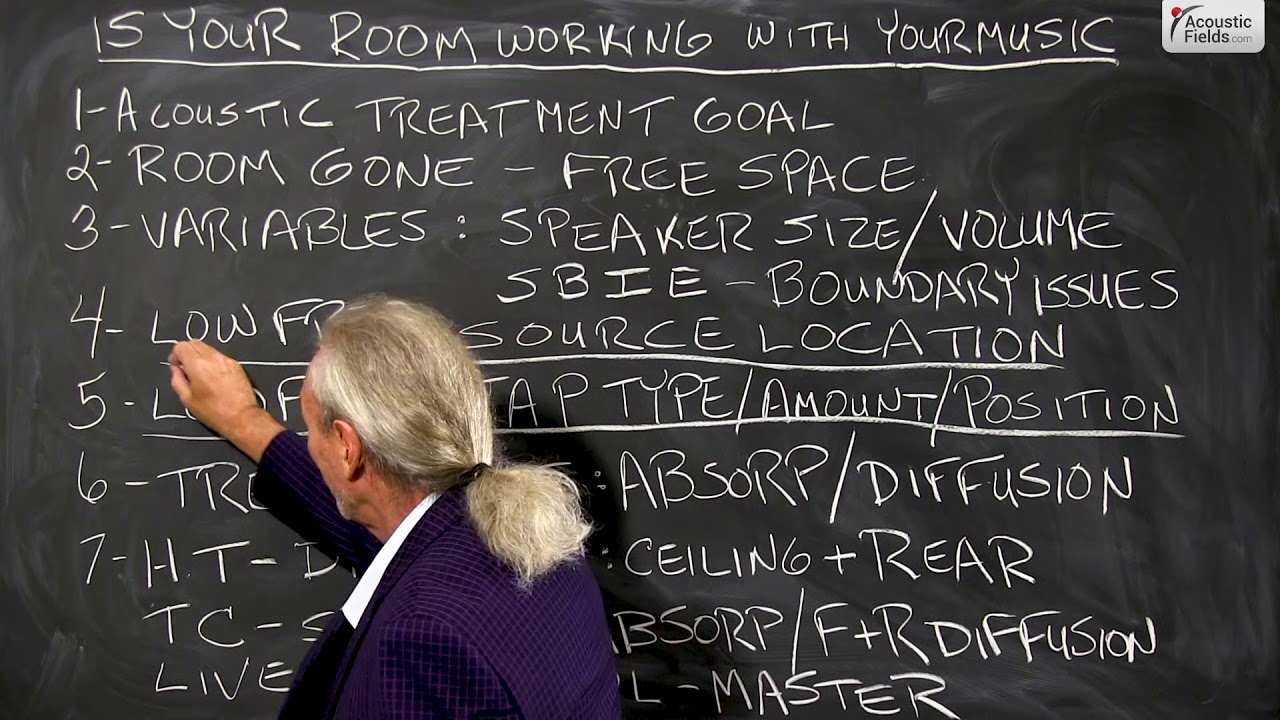Is your room working with your music? I get a lot of calls and I see a lot of room forms that come in where I’m really wondering who’s working with whom and the situation is the room fighting the music, is the music fighting the room, does the client just not know what’s going on, what’s the real issue here?
So let’s forget about the human factor in it and let’s just look at what the room requirements are, walk through a few examples and I think you’ll get an idea of what we need to do. The acoustic treatment of any room is to do one thing and that’s to get rid of the room. It’s to make the room go away so that you’re not hearing the artifacts of the room, you’re not hearing the ceiling, the walls, the floor, the noise coming through the structure.
So any good design of acoustical treatment is going to include all the technologies to make the room go away. And that’s all dependent on distance, size, volume and we’ve done numerous videos on those. So free space. Best sound you’ll ever hear. Take your system outside. Set it up in a really quiet area if you can find one. And put a chair in front of your two speakers and sit about six feet away. That’s the best you’ll ever have in sound. Because you’ll have no room, you’ll have only one boundary surface and that’s the earth. And with that we can pretty much live with. So free space is our goal. That’s the balancing act of absorption and diffusion treatments in their application to get that free space listening experience.
So what kind of variables are we up against in our room? Obviously the speaker has to match the size and volume of the room. Can’t put too much energy in too small of a room. Speaker boundary interference effect, our room boundary surfaces are always in the way, we always have to manage them. Some surfaces are more critical than others, depending upon usage but every boundary in our room is an issue, okay?
Low frequency source location. I see this a lot with home theaters. I see a lot of people that put the sub upfront next to the speakers, close to the speakers, in the corners which is something you never do. But the low frequency source, the subwoofer works on pressure, not localized energy. So you don’t really need it upfront to localize it because you’re not localizing it anyway, you’re feeling it. So it’s not the same kind of speaker, it’s not the same kind of energy generating source as your speakers are, okay? It needs special care. It needs a special location because it produces waves of energy that fit in almost no room so you have to be really careful.
Here’s another thing that you have to be really careful of. You have to know what your issues are in the low frequency area and you have to find the correct type, amount and positioning of the treatment. You can’t just put something here, put something there without knowing why you’re doing it. The amplitude and frequency of the problem in the room and the size and volume of the room will tell you location. And I can show you how to do that in another video.
Treatments. What are our options? We have absorption and diffusion. Those are the only two. I’ve been doing this 40 years, I can’t think of any more. Yeah, there’s all kinds of fancy names, there’s hybrids that companies give to products to make you think that it’s a new category but it’s really not if you look at the science behind it. So only two tools that we have in our toolbox. So we have to be very, very careful. How we use them, where we put them and how many we use?
So let’s take some examples to give you an idea of how different things are in different usages. Home theater, diffusion, sealing it rear wall almost constantly. Okay? Why are we doing that? Because we want to open the room up. We want to make it sound larger. The Dolby Atmos rooms, we have to be a little careful with diffusion on the ceiling but we’ll talk about that in another video also.
Two channel listening room, sidewalls, very, very critical the rate and level of absorption on the side wall because it’s directly responsible for central image definition and separation. That time signature on that reflection, off the side wall, mixing with the direct energy is critical. You can’t just use any type of absorption. You can’t use building insulation that was designed to keep your room or house warm or cold. You have to use technology that was specifically designed for voice and music, okay?
Live, control, master rooms all have different qualifications. The difference between a live and a voice room, night and day. Same technologies but the amount and position of all of them, it would be very different.
So try to do no harm in your room with your setup. Try to take into account that everything has value and good quality sound in a room is about doing a lot of little things correctly but more importantly, in the right order.
—
This is an unedited transcript from our video series from Acoustic Fields. There will be some errors in grammar and sentence structure that occur during this translation process.
For complete understanding and comprehension, please view the video which is included in this text. For any additional information regarding this topic or others relating to room acoustics, please contact us directly at:
P: 520 – 392 – 9486







